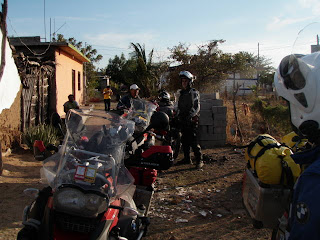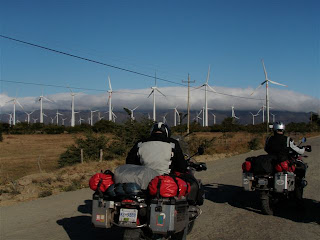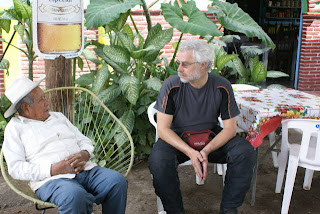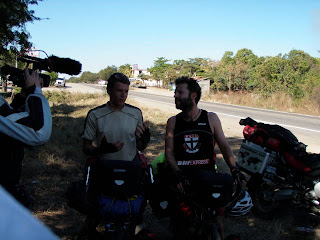Day 11-13 – January 15, 16 & 17
The city of Oaxaca is at an altitude of 5,084 feet and is situated in the middle of three valleys.
We drove through some fertile areas – it was sugar cane harvesting time and the cane was being harvested one stalk at a time – one man, one machete. The cane was delivered to the refinery in large trailers hauled two at a time by one semi and a variety of dump trucks. There was thick smoke in the air from the burning of residue in the fields. No doubt that at some point in the future some smart financial wiz will put some cash in his pocket by selling some carbon credits from not burning cane in the fields.
As we travel further south the land is more fertile and therefore larger farms which are more aggressively managed.
We broke our own rule about sticking to low calorie lunches – but I refuse to eat salads (the source of the dreaded Montezuma’s revenge) – something the rest of my group is neglecting.
Oaxaca also had a town square packed with people. Public displays of affection are commonplace, walking hand in hand, hugging and nuzzling - and statistics bear this out – Mexico has a crude annual birthrate of 21 births per thousand compared to the US – 14 births per thousand. This is due largely to the youthful population – 30% of Mexicans are under 15 versus 20% of the US population and 8% of Mexicans are over 60 versus 17% of the population of the US.
In the US the mall takes the place of the European style town square. There is not a lot of parking available near these squares - - people mostly walk to them and don’t mind walking 15 minutes to meet a friend.
As in Taxco, the square was active long into the night.
Our hotel in Oaxaca was a beautiful remodeled antique but unlike on the Silk Road, we could not park our motorcycles in the courtyard – they were unloaded in front and stored in a garage around the corner – you definitely do not want to leave it outside with the rampant petty theft.
The hotel had a lovely courtyard 
As we headed out of Oaxaca we again ran into heavy traffic
That included cramped motorbikes (no helmets)
The ever present mountains and puffy clouds
We spend much time adjusting helmet cameras – Roger, Vincent and I each have one. Helge may use some of our final video sequences for his DVD on our trip.
Helge takes some long distance shots with his tripod
At lunch we meet an 88 year old man who two years ago fell from a roof and had a compound fracture of his leg. Because his son is in the armed services, he was able to go to the “big hospital” in Oaxaca and his leg has healed nicely.
My lunch – I polished off an entire fish (not something I’m proud off)
The proprietor’s children watching television
We arrive in a fishing village near Tehuantepec 
And camp on a beach in front of what we hope is an abandoned building. The wind was howling and it was difficult to both set up and take down the tents.
We awoke to a beautiful sunrise
We find it’s easier to ride your bikes into the sand than to get them out
We head out towards our next stop in Tapachula and for a while share the road with some cattle.
We see that the Mexican government is taking advantage of the high winds as we pass a farm with hundred of wind turbines.
We ran into a couple of Brits who have cycled all the way from Prudhoe Bay – they will stop in Panama. Another group of Brits, to whom they are affiliated, will head from Panama to Tierra del Fuego. I can’t imagine doing this on bicycles – they have already been on the road five months and have another five months to go. Mexican roads do not have bike lanes so trucks are passing inches from their handlebars.
On this section of the ride my motorcycle begins skipping and then stops. It will run for 10 minutes then stop and when it cools it will run for another 5-10 minutes then stop again. It seems like a fuel flow problem but a mysterious one – the same sort of mysterious problem happened to me on the Silk Road on a different motorcycle. We drain the fuel and we have the same problem. Finally Helge concludes that we need to take the motorcycle apart and we find a partially loose connector in a heat sink area. We hypothesize that as the fuel pump runs, the heat sink increases in temperature and something inside expands acting as a shut-off switch. With the connector back in place and the bike reassembled, everything is running as it should.
Helge cuts a hole in the fender to permit even more air flow (not as evil as he appears in this picture)
We arrive at the Holiday Inn in Tapachula were Harriet has forwarded Roger’s title for his bike (Marge had brought along Roger’s original title - - the copy of which posed a problem crossing the border into Mexico). Unfortunately, we left Harriet’s without the title and she sent it via DHL-Mexico to hopefully arrive today (we will need it when crossing the border into Guatemala).
We will leave Mexico tomorrow and I wanted to reflect a bit on our experience.
The People
Everyone we’ve met has been friendly, from government officials to peasants to business men. They are willing to help, smile and are happy to see us. Some feel threatened by the American way of life and the American pace but they like Americans. The issue of violence is overplayed in the American press – it does not significantly affect US citizens visiting Mexico.
Drugs & Politics
Felipe Calderon, Mexico’s president of the PAN party, has a strong anti-drug agenda in place. But this agenda is in jeopardy even though he has a 70% approval rating, the PRI party (the party that lead Mexico for 40 years before the PAN party gained control with Fox and Calderon) has regained more seats in the lower house (probably due to lower tourist revenues, lower tax receipts and the requirement for a smaller national budget). The people I met at Harry’s bar suggest that Calderon’s anti-drug interest is aligned with the US but also will help decrease revenues that the PRI derives indirectly from drug trafficking. In general Mexicans are not sympathetic to America’s appetite for drugs and are not happy with the 1,000 of Mexicans killed each year in drug wars. If Calderon is replaced with a PRI president, it is likely that the aggressive anti drug campaign will be sacrificed (a bigger drug problem for the US and could herald a move towards the type of lawlessness present in Columbia 10 or more years ago).
Economics
Mexico has a GDP per person of $13,900 compared to $4,900 in China, $8,200 in Columbia, 11,600 in Turkey and $46,300 in the US. With 111 million people, it is a big prosperous country with an advanced economy – by far the leading economy in the America’s south of the US border. NAFTA has worked for both Mexico and the US. Since NAFTA the two-way trade between the US and Mexico grew from $81 billion in 1993 to $231 billion in 2002. Mexico now has a $32 billion trade surplus. NAFTA’s promise to Mexico was that it would export “goods and not people” and in the 15 years under NAFTA Mexico’s exports have quintupled to $292 billion. Until last year, they were still exporting a half million people per year seeking employment in the US.
The largest pressure has been on Mexican farmers who cannot compete with large, efficient US farms that produce staple crops like wheat. 22% of Mexico’s labor force works in agriculture but it generates only 4.4% of the GDP. Mexican agriculture is notoriously inefficient – 50% of Mexico’s farmers till plots that are less than 15-20 acres and earn less than 1/3 of their income from agriculture. The good news is that 20% of Mexico’s GDP is attributable to trade made possible by NAFTA provision.
The US is graced with only two big neighbors and it is terribly important that they both remain healthy.
Back to Top











- bob mcintyre -
May 20, 2011, 11:30 am
Add A CommentDan...
..Nice documentaion of your travels, is that Helge Peterson?
While my travels are usually 4 wheel in defenrece to my wife, we seem to seek out the same non tourist sort of experiences and observations...especially in Mexico..a small hotel in Valladolid, the non public ruins in Ek Balam
Also, I read somewhere that you were organizing some local , short rides for the 'mature' riders...I have only been riding continously since high school in Michigan in '61 so I might not be as experienced as you might want in your group..in any event if you can give me some info it would be appreciated...
Bob
Add A Comment